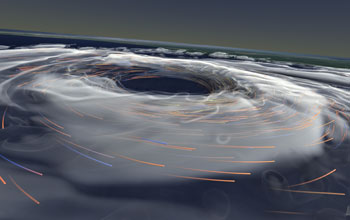Multimedia Gallery
Still from simulation showing evolution of Hurricane Katrina
A still from a simulation of Hurricane Katrina. The National Center for Atmospheric Research computed a complex numerical model of the evolution of the conditions of the storm. The visualization was created by the Advanced Visualization Laboratory at the National Center for Supercomputing Applications and shows the storm’s evolution over a one-and-a-half-day period, as the storm gains energy over the warm ocean. Volume-rendered clouds show abundant moisture. Trajectories follow moist air rising into intense "hot tower" thunderstorms, and trace strong winds around the eye wall; rapidly rising air is yellow, sinking air blue.
[NCAR is supported by the U.S. National Science Foundation.]
Learn more and view the full simulation Here. (Date of Image: 2011)
Credit: Advanced Visualization Laboratory, National Center for Supercomputing Applications; NCSA AVL contributors: Donna Cox, Robert Patterson, Stuart Levy, Alex Betts, Matthew Hall; NCAR team members: Wei Wang, Ryan Torn, Jimy Dudhia, Chris Davis
See other images like this on your iPhone or iPad download NSF Science Zone on the Apple App Store.
Images and other media in the National Science Foundation Multimedia Gallery are available for use in print and electronic material by NSF employees, members of the media, university staff, teachers and the general public. All media in the gallery are intended for personal, educational and nonprofit/non-commercial use only.
Images credited to the National Science Foundation, a federal agency, are in the public domain. The images were created by employees of the United States Government as part of their official duties or prepared by contractors as "works for hire" for NSF. You may freely use NSF-credited images and, at your discretion, credit NSF with a "Courtesy: National Science Foundation" notation.
Additional information about general usage can be found in Conditions.
Also Available:
Download the high-resolution JPG version of the image. (1.9 MB)
Use your mouse to right-click (Mac users may need to Ctrl-click) the link above and choose the option that will save the file or target to your computer.



 All images in this series
All images in this series